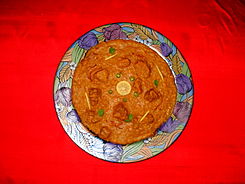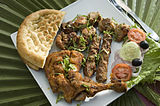Khichra
This article needs additional citations for verification. (September 2014) |
 Khichra | |
| Type | Stew |
|---|---|
| Place of origin | Indian subcontinent |
| Associated cuisine | India, Bangladesh, Pakistan |
| Main ingredients | Meat, lentils, spices |
| Variations | Beef khichra, chicken khichra, mutton khicra |
Khichra or Khichda (Template:Lang-ur) is a variation of the dish Haleem, popular with Muslims of the Indian subcontinent. Khichra is cooked all year and particularly at the Ashura of Muharram. It is made up of goat meat, beef, lentils and spices, slowly cooked to a thick paste.[1] It is the meat based variant of rice dish from the Indian subcontinent called Khichdi.[2] In Pakistan, beef Haleem and Khichra is sold as street food in most cities throughout the year.[3][4]
Origin
Khichra and Haleem are basically the similar dishes as meat is grinded in Haleem while meat is in shape of cubes in Khichra.[5]
The origin of Haleem lies in the popular Arabian dish known as Harees (also written as Jareesh). According to Shoaib Daniyal, writing in The Sunday Guardian, the first written recipe of Harees dates back to the 10th century, when Arab scribe Abu Muhammad al-Muzaffar ibn Sayyar compiled a cookbook of dishes popular with the "kings and caliphs and lords and leaders" of Baghdad. "The version described in his Kitab Al-Tabikh (Book of Recipes), the world’s oldest surviving Arabic cookbook, is strikingly similar to the one people in the Middle East eat to this day" it reported. Harees was introduced by Arab soldiers of the Hyderabad Nizam's army to the city.[6][7][8]
As per the Delhi based historian Sohail Hashmi, the Khichra originated as a famine relief measure in the North Indian city of Lucknow while building the Old Imambara of Lucknow. Due to a famine, the then Nawab of Awadh commenced the construction of an Imambargah, announcing that anyone who participated in the construction would be given free food. This free food consisted of rice slowly cooked with mutton and various pulses, thus becoming rich in protein and carbohydrates. This aided a number of famine affected people who would otherwise have died. Once the construction of the Imambargah was completed, the dish continued to get popular and can today be found not just in Lucknow, but a number of cities of the Indian subcontinent. Travellers took this dish to other parts of the Indian subcontinent, where it further acquired a local flavor.[9]
Haleem, Khichra and Khichri
In the Indian subcontinent, both Haleem and Khichra are made with same ingredients. Haleem is cooked until the meat blends with the lentils, while in Khichra chunks of meat remains as cubes.[10][11][12]
Khichra is similar to Haleem and is a meat dish. While Khichri is a vegetarian dish with rice and pulses or lentils.
See also
References
- ^ "The slow-cooked goodness of Haleem". The Times of India. Retrieved 28 November 2014.
- ^ Dalal, Tarla (1 January 2007). The Complete Gujarati Cook Book (1st ed.). Mumbai: Sanjay & Co. ISBN 978-8186469453.
- ^ Karachi Food Street
- ^ Food for thought: Haleem by any other name
- ^ Difference between Khichri, Khichra and Haleem
- ^ "The history of haleem". The Sunday Guardian.
- ^ "A culinary history of Haleem". The Times of India.
- ^ Ihsaan Abrahams. "Haleem". Islamic Focus. Retrieved 28 November 2014.
- ^ Hashmi, Sohail. "Interview - Ravish Kumar Sohail Hashmi - NDTV Prime 9 September 2016 (The Biryani Controversy)". NDTV. NDTV.
{{cite web}}: Missing or empty|url=(help) - ^ Nidhi Raizada. "It's Indian Everyday: Difference between Khichri, Khichra and Daleem". Retrieved 28 November 2014.
- ^ [1]
- ^ Raizada, Nidhi. Desi Cook Book. Mumbai.




